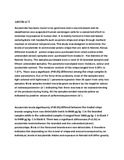| dc.contributor.author | Ogolla, Jackline A. | |
| dc.contributor.author | Abong’, George O. | |
| dc.contributor.author | Okoth, Michael W. | |
| dc.contributor.author | Imungi, Jasper K. | |
| dc.contributor.author | Kabira, Jackson N. | |
| dc.contributor.author | Karanja, Paul N. | |
| dc.date.accessioned | 2013-12-04T12:41:40Z | |
| dc.date.available | 2013-12-04T12:41:40Z | |
| dc.date.issued | 2012 | |
| dc.identifier.citation | Jackline A. Ogolla, George O. Abong’, Michael W. Okoth, Jasper K. Imungi, Jackson N. Kabira and Paul N. Karanja, The seventh Egerton University International Conference: Research and Expo, From 2012-09-26 To 2012-09-28 | en_US |
| dc.identifier.uri | http://hdl.handle.net/11295/61756 | |
| dc.description.abstract | Acrylamide has been found to be genotoxic and a neurotoxicant and its classification as a suspected human carcinogen calls for a concerted effort to minimize its presence in human diet. It is mainly formed in fried and baked carbohydrate rich foodstuffs such as potato chips and crisps through maillard reaction at elevated temperatures. This study was designed to determine the levels of acrylamide in commercial potato crisps that are sold in Nairobi, Kenya. Different brands of potato crisps were purchased from retail outlets while unbranded (street) samples were purchased from kiosks in five districts of the Nairobi County. The samples purchased were a total of 35 branded samples and fifteen unbranded samples. The parameters analysed were moisture, colour and acrylamide content. The moisture content of the crisps ranged from 0.39% to 7.97%. There was a significant (P≤0.05) difference among the crisps samples in color parameters. Out of the forty three products, most of the samples were light colored with lightness (L*) parameters greater than 50 apart from only two samples. Most samples tended towards green as shown by the negative values of redness parameter (a*) indicating that there was less or no excess browning of the products during frying. All the samples tended towards yellow as indicated by positive values of yellowness parameter (b*).
Acrylamide levels significantly (P≤0.05) differed between the traded crisps brands ranging from non-detectable levels to 8666 μg kg−1 in the branded samples while in the unbranded samples it ranged from 5666 μg kg−1 in Kiosk 7 to 9499 μg kg−1 in Kiosk 6. There was a significant differences (P<0.05) in acrylamide levels between the branded and the unbranded (street) potatocrisps. Most of the flavoured brands were non-detectable. It therefore indicates that depending on the brand of crisps and amounts consumed by an individual, levels of acrylamide intake and exposure in Nairobi will differ greatly. | en_US |
| dc.language.iso | en | en_US |
| dc.publisher | University of Nairobi, | en_US |
| dc.subject | Acrylamide | en_US |
| dc.subject | Potato crisps | en_US |
| dc.subject | Carcinogen | en_US |
| dc.subject | Processing | en_US |
| dc.title | The seventh Egerton University International Conference: Research and Expo | en_US |
| dc.type | Presentation | en_US |

